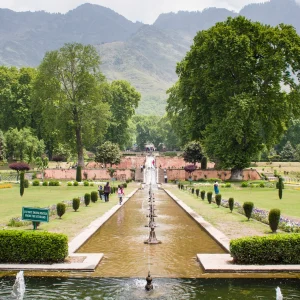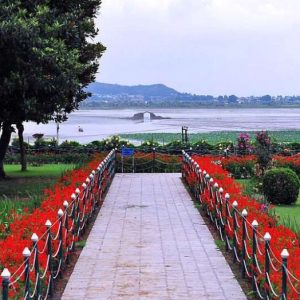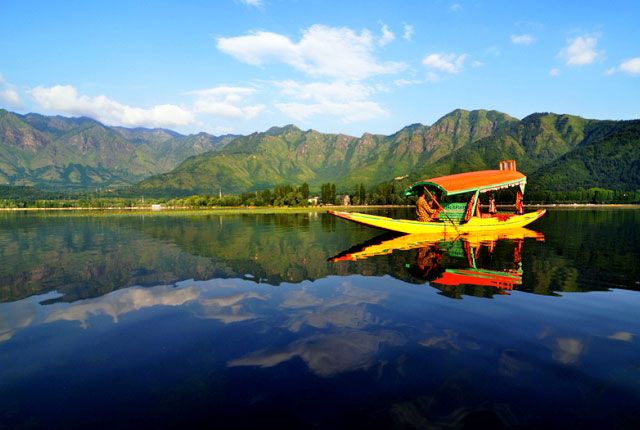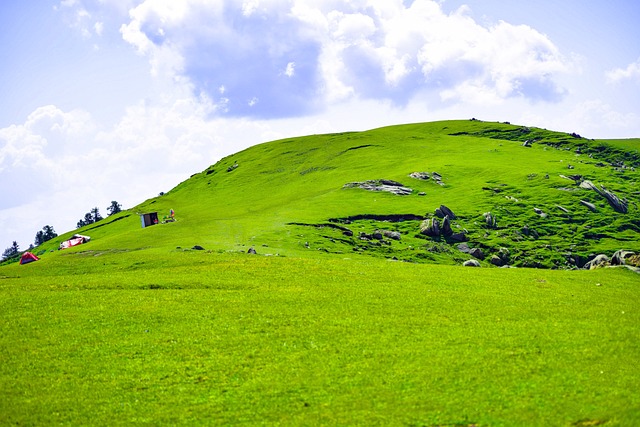
Nishat Bagh : The Majestic Mughal Garden of Kashmir
Table of Contents
ToggleOverview
Nestled in the heart of Srinagar, Kashmir, Nishat Bagh is a highly beautiful presentation of Mughal garden design and landscape architecture. The terraced gardens, intricate water system, and panoramic views over Dal Lake give this “garden of joy” its bewitching view into rich history and the grandeur of the Mughal Empire. This royal garden is a manifestation of beauty, art, and culture to testify the love of Mughal emperors in making a paradise on earth.
Spread over an area of 46 acres, Nishat Bagh is the miracle in botany and history. Built during the reign of Emperor Jahangir in the year 1633, it stood the test of times, offering to the visitors a serene, immersed experience that combines natural beauty, meticulous architectural design, and royal heritage. This blog takes deep insights into the history, architecture, cultural significance, and sheer splendor of Nishat Bagh, making it a must-visit for anyone who steps into this enchanting valley of Kashmir.





Nishat Bagh: Part of Mughal Legacy History in Kashmir
The origin itself has its roots deep within the wealth and cultural establishment brought forth by the Mughal Empire. Informed of gardens and great lands to ornament, the Mughals sought to transfer the idea of paradise garden they had successfully cultivated elsewhere to Kashmir as the empire extended into this valley. This is in Nishat Bagg, which was a commission by Asif Khan, the brother of the Empress Nur Jahan and the father of the inspiration for the Taj Mahal.
Nishat Bagh was built as far back as 1633. Though constructed piecemeal, during the time of Emperor Jahangir, Asif Khan himself was in charge of the whole building. It was not only a royal retreat for the Mughal family but also an image of the power and aesthetic sensibilities of the dynasty. “Nishat Bagh” is its literal name, which means “The Garden of Joy,” the intention for which it is created-to be a relaxing, pleasing, and spirit-filled retreat for the royal court.
Paradisiac representations to the Mughal emperors, which include garden lands and filled up with streams and falling waters in different aspects, filled with full-grown flowers and scent-bearing trees. Nishat Bagh is, one such example in this approach; the whole garden layout gives an elegance that a piece of work done not from man but created by mother nature, combined with some well-maintained human architecture in its outlook.
Architectural Features of Nishat Bagh: The Best Blend of Nature with Mughal Design
Architectural brilliance lies in its symmetry, integration of water features, and use of terraced levels to create a visually stunning and harmonious garden. The traditional Mughal style of garden design is followed by it, which is based on the four-fold plan that represents the four rivers of paradise. Flowing water, lush greenery, and well-planned plantings combine together to ensure that every nook and corner of the garden turns out to be an enchanting spectacle.
Terraced Layout
Nishat Bagh is divided into 12 terraces that would descend from the top-most point of the garden downwards to the lower levels just in order to provide a visual graduation that gives depth and richness to the garden. With each level, pathways and flowerbeds, along with water channels, have been set out carefully to provide the visitor with visual focal points.
The central axis of the garden is the most important element of design: it runs from the main entrance up to Dal Lake. Thus, the central axis works like a spine for the garden, from which all other elements of landscape radiate out. Terraces are designed in this way so that they give an optical illusion of largeness; with the eye shifted horizontally from one level to another, the garden would be much larger than a physical space.
Water Features: The Integral Component of Mughal Gardens
Water is an element used in Mughal garden design to symbolize life and purity. Nishat Bagh is not an exception. The garden is strewn with a sequence of channels, fountains, and cascading pools that stretch from one terrace to the next. The main water channel stretches along the entire length of the garden and boasts stunningly well-manicured flowerbeds and trees on either side.
The water features of Nishat Bagh are not only beautiful but also masterpieces of engineering. The water flow in the garden has been so designed that each of the terraces is fed by a constant flow that cascades down to the lower one. This irrigation and water system is a marvelous testimony to the ingenuity of Mughal engineers.
Pavilions and Architecture
Beautiful pavilions dot the entire terraces, where tourists can sit back and take in the beauty of Nishat Bagh. The most beautiful of the pavilions is known as the “Sheesh Mahal” or the “Palace of Mirrors.” Its beauty was said to have been due to the delicate glasswork and the mirror-panel work that covered its structure. A lot of this work is missing today, but still, the pavilion is breathtaking in its Mughal beauty.
The pavilions are constructed in Nishat Bagh in such a way that they may provide the best view of Dal Lake and the mountain ranges surrounding it, hence becoming the best relaxing places. The architectural designs of the pavilions are a blend of the Mughal aesthetics along with the local Kashmiri tastes, which make it an unique and harmonious style.
Floral Displays and Plant Diversity
Nishat Bagh is decorated with diverse species of flora, like cypress trees, roses, lilies, and seasonal flowers. They are aligned in specific patterns that add beauty to every platform, flowerbeds, and lawns, thereby giving riot of colors throughout the year.
The spring months are just beautiful because the garden blooms to its full beauty with tulips, roses, and lilies. During the summer months, the green lushness is cool and refreshing; during autumn, the hues of changing leaves give it a golden glow. The garden being full of different plant species makes each visit to this place different.
The Symbolism of Nishat Bagh: Beyond Beauty
Nishat Bagh is more than a monument to the architectural acumen of the Mughal Empire; it holds deep symbolic meaning. The design of the garden, complete with water systems and plant arrangements that are intricate and beautiful, was meant to represent paradise on earth. According to Mughal emperors, gardens were an expression of divine beauty, and so Nishat Bagh was designed to evoke peace, tranquility, and spiritual rejuvenation.
The four-fold garden is called Charbagh, which symbolizes the four rivers of paradise in Persian tradition. Nishat Bagh follows this tradition with the water channels flowing through the garden as a representation of the life-giving waters of these rivers. The carefully measured symmetry of the garden layout symbolizes the harmony between humans and nature.
In a more general sense, Nishat Bagh shows how the Mughal Empire ruled the region. They tried to enhance their power and influence throughout the entire region through this lovely, big garden, one of the most beautiful places known-Kashmir. The time also indicates this aspect where all the Persian, Central Asia, and Kashmiri designs were in fine harmony.
Travel Information to Nishat Bagh: A Comprehensive Guide
Nishat Bagh is one of the most favored attractions in Kashmir that attract people from across the world. Plan your visit here and learn about how to prepare for one of your dream vacations visiting these majestic Mughal gardens.
Best Time to Visit Nishat Bagh
The above proves that Nishat Bagh is quite a different experience at its best during various seasons and that a proper time to visit holds the key to the greatest time in the garden.
- Spring (March to May): These are the best times with full floral beauty in them. The gardens are brimming with colorful tulips, lilies, and rose fragrances.
- Summer (June to August): The weather is warm, but not oppressive, and the garden’s lush greenery provides a cool, refreshing atmosphere.
- Autumn (September to November): The foliage turns golden and red, creating a mesmerizing visual spectacle. The cooler temperatures make for comfortable sightseeing.
- Winter (December to February): If you’re seeking a tranquil and serene experience, winter offers a magical atmosphere as the garden gets dusted with snow.
How to Reach Nishat Bagh
Nishat Bagh is situated along the eastern shores of Dal Lake and can be easily approached from Srinagar. Here is how you can reach the garden:
- By Air: The closest airport is Sheikh Ul-Alam International Airport (Srinagar Airport), which is about 25 km from Nishat Bagh. From the airport, one may avail of a taxi or pre-arrange a transfer to reach the garden.
- By Train: Srinagar has very few railway connections; you can take the train to Jammu railway station, which is really connected to all major Indian cities, and then by driving reach Srinagar.
- By Road: Srinagar has also very good road connection to other parts of Kashmir as well as India. It connects National Highway 44 connecting Jammu to Srinagar. You may also hire a taxi from city or board a local bus from the city up to Nishat Bagh.
Seeking the Environs of Nishat Bagh
Nishat Bagh is close to other major attractions in Srinagar and so it is easy to find more of the region to discover during your visit.
- Dal Lake: No visit to Nishat Bagh is complete without a Shikara ride on Dal Lake. The lake’s serene waters and floating houseboats do offer a unique perspective to the garden.
- Shankaracharya Temple: Situated atop a hill where panoramic views of Srinagar and Dal Lake are witnessed.
- Mughal Road: The view of the region’s nature and historical landmarks could be cherished with a scenic road trip via the Mughal Road.
- Hazratbal Shrine: It is at the northern end of Dal Lake, so Hazratbal Shrine is peaceful religious site with serene views of the lake.
Conclusion: A Timeless Jewel of Kashmir
Nishat Bagh is much more than a garden; it is a timelessness tribute to the architectural brilliance and cultural grandeur of the Mughal era. Its terraced levels, water channels, vibrant floral displays, and regal pavilions make it an enchanting experience to visit. Stepping into Nishat Bagh is stepping into a living masterpiece, a paradise on earth, designed by the finest artisans of their time.
Nishat Bagh is a perfect destination for any art lover, a history buff, or any person who simply loves nature. The garden has deep cultural, architectural, and natural beauty that makes it a must for any itinerary of Kashmir. It has peaceful surroundings, great views, and rich history that ensures Nishat Bagh would forever be one of the most captivating and unforgettable places to visit in the region.
How to book Kashmir tour?
Contact a travel agency that specializes in Kashmir tours. You can reach out to the following for assistance:
- Phone:
- +91 7889 655596
- +91 7006 891267
- Email:
Inquire about tour packages, itineraries, and pricing, and confirm your booking for a memorable winter experience!
People Also Ask
What is Nishat Bagh?
Nishat Bagh is a historical Mughal garden located in Srinagar, Jammu and Kashmir. It is the second-largest Mughal garden in the region, known for its symmetrical design, terraced layout, and stunning views of Dal Lake.
Where is Nishat Bagh located?
Nishat Bagh is situated on the eastern side of Dal Lake in Srinagar, Jammu and Kashmir, India. It is around 11 kilometers from the Srinagar city center.
When was Nishat Bagh built?
Nishat Bagh was built in 1633 AD by Asif Khan, the brother of Empress Nur Jahan and the father of Mumtaz Mahal (the wife of Emperor Shah Jahan).
What is the significance of Nishat Bagh?
Nishat Bagh is an important Mughal garden, representing the zenith of Mughal landscaping and design. It is known for its architectural beauty, terraced layout, fountains, and floral designs. The garden also has historical significance as a royal retreat.
How do I reach Nishat Bagh?
Nishat Bagh can be accessed by road from the city center of Srinagar. You can hire a taxi or take a local bus. It is also easily reachable by a boat ride across Dal Lake from the main city.
What is the best time to visit Nishat Bagh?
The best time to visit Nishat Bagh is during the spring (April to June) and summer (July to September) months when the flowers are in full bloom. The garden is also popular in autumn, offering beautiful views of the changing colors.
What makes Nishat Bagh unique?
Nishat Bagh is known for its unique Mughal design, featuring 12 terraced levels, a central canal with fountains, and spectacular views of Dal Lake and the Zabarwan Range. The garden’s layout emphasizes symmetry, which is a hallmark of Mughal architecture.
Is there an entry fee for Nishat Bagh?
Yes, there is a nominal entry fee to visit Nishat Bagh. However, fees can vary depending on the time of visit or whether it’s a special event or festival period.
What are the key attractions in Nishat Bagh?
Key attractions in Nishat Bagh include the terraced gardens, fountains, the central water channel, and the beautiful floral designs. The view of Dal Lake from the garden is also a major highlight.
Is Nishat Bagh open year-round?
Yes, Nishat Bagh is open year-round. However, the best experience is during spring and summer when the garden is lush and in full bloom.
What is the architectural style of Nishat Bagh?
Nishat Bagh follows the typical Mughal garden style, featuring a series of terraced levels with symmetrical paths, fountains, and waterways. The design represents the concept of “paradise on earth,” typical of Mughal garden architecture.
Can I take photographs in Nishat Bagh?
Yes, photography is allowed in Nishat Bagh, and it is a popular activity due to the beautiful landscapes, historical architecture, and scenic surroundings.
What kind of plants and flowers are found in Nishat Bagh?
Nishat Bagh is home to a wide variety of plants, flowers, and trees, including colorful tulips, roses, lilies, and cypress trees. The garden is especially famous for its spring bloom.
Can I have a picnic in Nishat Bagh?
Yes, Nishat Bagh is a peaceful place for picnics. Many visitors enjoy relaxing by the fountains and admiring the views while enjoying a meal in the garden.
How much time should I spend in Nishat Bagh?
On average, visitors spend around 1 to 2 hours exploring the garden. If you are interested in photography or relaxing, you may want to spend more time.
Is Nishat Bagh wheelchair accessible?
While the garden is large and has terraced levels, some parts of Nishat Bagh may not be fully wheelchair accessible due to the stairs. However, some areas are easier to navigate.
Are there any restaurants or cafes in Nishat Bagh?
There are no major restaurants or cafes directly inside Nishat Bagh, but there are plenty of food stalls and local eateries around the garden, especially near Dal Lake.
Is there any parking available at Nishat Bagh?
Yes, there is parking available near the entrance of Nishat Bagh, but it can get crowded during peak tourist seasons. It’s best to visit early in the morning or later in the evening to avoid crowds.
Is Nishat Bagh suitable for families with kids?
Yes, Nishat Bagh is a great place for families with kids. The peaceful atmosphere, fountains, and gardens make it an ideal spot for relaxation and enjoying nature.
Are there any nearby attractions to visit along with Nishat Bagh?
Nearby attractions include Dal Lake, Shankaracharya Temple, Mughal Gardens (like Shalimar Bagh and Chashme Shahi), Hazratbal Shrine, and the Nishat Market.
Is Nishat Bagh a good spot for photography?
Yes, Nishat Bagh is a photographer’s paradise, with its symmetrical layout, fountains, vibrant flowerbeds, and breathtaking views of Dal Lake and the Zabarwan Range.
Are there any festivals celebrated at Nishat Bagh?
While Nishat Bagh itself doesn’t host specific festivals, it is a popular spot for tourists during the spring (Tulip Festival) and summer when flowers are in full bloom.
What is the meaning of Nishat Bagh?
Nishat Bagh means “Garden of Joy” or “Garden of Delight” in Persian, reflecting the beauty and tranquility of the garden.
Can I visit Nishat Bagh by boat?
Yes, you can reach Nishat Bagh by boat from Dal Lake. A boat ride provides a scenic and peaceful approach to the garden.
Are there any historical facts about Nishat Bagh?
Nishat Bagh has a rich historical background and was built by Asif Khan, the brother of Empress Nur Jahan, in 1633 AD. It was a retreat for the Mughal emperors and has remained one of the most important Mughal gardens in Kashmir.




